KoiosPhoebus
Hazard to Self
 
Posts: 51
Registered: 23-1-2023
Member Is Offline
|
|
Kojic acid metal complexes
Kojic acid is a naturally-occurring monoprotic 3-hydroxy-4-pyrone and as such forms
stable metal complexes. I recently bought some kojic acid and a couple of batches of ethylmaltol (another 3-hydroxy-4-pyrone) to experiment with
preparing metal complexes. Unfortunately, I doubt that the "ethylmaltol" was actually ethylmaltol (or if it was, it was severely contaminated)^ so
here I'm just going to discuss the kojic acid metal complexes (i.e. kojates)
The iron(III)-tris(kojate) complex is reasonably well-known so I decided to try a different metal first - manganese(II). Manganese(II) kojate
complexes have been prepared in the past by reacting manganese(II) acetate and kojic acid in ethanol - Mn(II)-bis(kojate) has low solubility in
ethanol so it mostly precipitates out (refs: https://doi.org/10.1016/S0968-0896(03)00070-1, https://doi.org/10.1016/j.bmcl.2006.09.097). Unfortunately I don't have Mn(II) acetate so instead I used double-displacement between lithium
kojate and MnCl2 in solution:
0.84 g of lithium hydroxide monohydrate was dissolved into ~10 mL of water. While lithium hydroxide is somewhat soluble in ethanol,
I decided that it would be quicker to dissolve it into water first and then add the dissolved LiOH to ethanol.
2.90 g of kojic acid (~0.02 mol) was dissolved into ~20 mL of ethanol. A small excess was used as it would remain soluble in the ethanol and I'm
not confident in the purity of the kojic acid.
The ethanol solution of kojic acid was added to the aqueous solution of LiOH. Initially a white precipitate formed (likely the LiOH) but with
some stirring it disappeared. Interestingly, the solution turned red, with some brownish-red precipitate. My suspicion is that the kojic acid was
slightly contaminated with iron, some of which hydrolysed to form Fe(OH)3 and then Fe2O3 upon the addition of the
very alkaline LiOH solution. Kojate forms a very strong intensely-coloured red 3:1 complex with Fe(III) (log β = 26.5, which is higher than Fe(III)-EDTA (log K = 25.1)) so it makes sense that some Fe(III)-kojate complex would remain in solution even
at high pH.
Ethanol was then added to the lithium-kojate solution to a total of 50 mL. Mn(II)-kojate is soluble in water but minimally soluble in ethanol,
so this was done to maximise yield. The lithium kojate solution was left stirring for an hour as I was trying to see if the brown precipitate
described above would dissolve, but it did not.
Separately, 1.98 g of manganese(II) chloride tetrahydrate was dissolved into 50 mL of ethanol.
The lithium kojate solution was then filtered and added into the MnCl2 solution. As the lithium kojate dripped into the
MnCl2, a fluffy light yellow precipitate of Mn(II)-kojate formed:
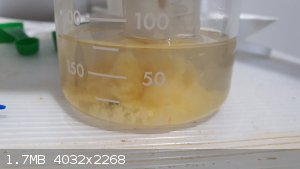
After all the lithium kojate was added, I stirred the solution and then filtered off the Mn(II)-kojate. Vacuum filtration was used as I
suspected that the "fluffy" structure of the Mn(II)-kojate would make it difficult to remove all the solvent (which contains LiCl as a side-product)
from the precipitate.
I washed the light yellow precipitate twice with ethanol to remove any remaining lithium chloride or excess kojic acid. Interestingly, Mn(II)
kojate is very slightly soluble in ethanol so the ethanol that filtered through had a slight yellow tinge to it.
After pulling all of the ethanol out from the Mn(II) kojate, I then scraped/washed it off with ethanol and dried it on a hotplate at around 60
deg C. Some of the light yellow precipitate at the top turned a darker shade of yellow, which may be due to oxidation. Unfortunately, I don't have a
vacuum pump so drying in vacuo as the literature did was not an option.
The yellow chunks were crushed to form a light yellow powder. Interestingly, the surface layer of the chunks were definitely a darker yellow
than the core, suggesting that the outer layers might be somewhat oxidised.
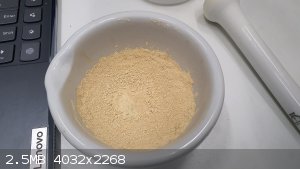
All in all, the yield was 3.29g, which is about 95% of theoretical (the literature suggests that manganese(II) kojate precipitates as the hemihydrate,
which should have a molar mass of 346.148 g/mol). Given that some of it should have been lost to washing or in the initial filtrate (the water
component dissolved some Mn(II)-kojate), I wonder if the degree of hydration is higher than suggested in literature. It would make sense as the
literature performed their reaction in absolute ethanol but my method used 10% v/v water/ethanol.
The complex is actually a lighter yellow than in the photos above; it actually resembles the yellow of the current Sciencemadness post backgrounds.
It's rather reassuring that it clearly matches up with literature; often when working with readily-oxidised metal ion complexes (Fe(II), Mn(II)), I
either get something completely different from the literature (and have to work out what happened) or complexes where the colour resembles that of the
oxidised metal ion, making it difficult to work out if I actually got the intended product. For example, Mn(II) amino acid complexes can be "pale
brown" (https://doi.org/10.1016/S0277-5387(97)00211-8) which is difficult to distinguish from the brown of Mn(III)-hydroxide/oxide-hydroxide. Fe(II)-amino
acid complexes can be "orange" (https://doi.org/10.1016/S0020-1693(00)82257-4) or, hell, even "brick-red" (https://doi.org/10.1071/ch9750773) which can make it difficult to tell if I've synthesised the iron(II) amino acid complex, a species with a
hydroxide attached, an iron(III) amino acid complex (which are also orange-red in colour - for an example, see iron(III) glutamate), or even just fancy iron(III) oxide/hydroxide. Light yellow, on the other hand, makes it very clear that the primary species
formed was the Mn(II)-bis(kojate) complex.
^: I got my ethylmaltol from Aliexpress both times, from the two listings that are currently up as of 12/Dec/2023. Both
times I observed the following:
There was a slight bitter/metallic taste - ethylmaltol is a sweetener described as having a fruity taste.
The "ethylmaltol" readily dissolved into room-temperature water, which is odd as ethylmaltol has somewhat low solubility in water.
The "ethylmaltol" did not dissolve into ethanol, propylene glycol, or acetone. Makes no sense, given that practically all literature records
ethylmaltol as being highly soluble in most polar organic solvents. One seller even declared that ethylmaltol is soluble in "alcohol, 12%" and
"propylene glycol, 5.5%"!
When a strong base e.g NaOH or LiOH was added to the "ethylmaltol" solution, a precipitate was formed. This is bizarre as maltol/ethylmaltol
usually becomes more soluble in base because it's being deprotonated!
I did try to mix the "ethylmaltol" with some iron(III) ions to see what would happen. A light red complex formed, which suggests to me that there was
some small amount of ethylmaltol in there but it was heavily adulterated. I also tried the above procedure with the "ethylmaltol" in place of the
kojic acid, but instead of getting a yellow complex, I got a yellowish-brown precipitate with the appearance of sand, which gradually turned to dark brown when exposed to air.
I suspect that the manufacturers may have added something to solubilise the ethylmaltol, which would explain the relatively light red Fe(III) solution
and the darkening of the Mn(II) precipitate - possibly due to formation of an Mn(II) hydroxide or a basic Mn(II) complex (e.g. M(OH)L instead of
ML2) which oxidised on exposure to oxygen. I have no idea what it could be, though, as the "ethylmaltol" solution pH was about 5.5 (i.e.
it's probably not a strong acid or a strong base).
|
|
|
DraconicAcid
International Hazard
    
Posts: 4278
Registered: 1-2-2013
Location: The tiniest college campus ever....
Member Is Offline
Mood: Semi-victorious.
|
|
Cool idea. Since manganese tends not to form amine complexes, you could use ammonia as the base, so as to have less water in the reaction mixture.
I'm also wondering if ethylenediamine would react with kojic acid to make a salen-type ligand.
ETA: AliExpress has been trying to sell me kojic acid since I ordered my first chemical there, so I wish I'd checked its properties more closely
then.
[Edited on 12-12-2023 by DraconicAcid]
Please remember: "Filtrate" is not a verb.
Write up your lab reports the way your instructor wants them, not the way your ex-instructor wants them.
|
|
|
KoiosPhoebus
Hazard to Self
 
Posts: 51
Registered: 23-1-2023
Member Is Offline
|
|
Quote: Originally posted by DraconicAcid  | Cool idea. Since manganese tends not to form amine complexes, you could use ammonia as the base, so as to have less water in the reaction mixture.
I'm also wondering if ethylenediamine would react with kojic acid to make a salen-type ligand.
[Edited on 12-12-2023 by DraconicAcid] |
Thanks for the suggestion - unfortunately the only source of ammonia I have is
aqueous ammonia (though I suppose I could generate it using ammonium salt + base...).
I don't have ethylenediamine (and no analytical way to verify chemical structure) so the salen ligand will have to stay theoretical for now. If I'm
not mistaken however, doesn't the formation of the salen ligand occur through a reaction between ethylenediamine and the aldehyde group of
salicylaldehyde? I'm not sure if the oxo-group of kojic acid can condense the same way.
Another interesting reaction with ethylenediamine which might work would be to prepare chlorokojic acid through reaction with thionyl chloride, then
react chlorokojic acid with ethylenediamine. Nucleophilic substitution of the halogen group is reasonably well-established as a method for preparing
other chelating agents, e.g. ethylenediamine disuccinic acid (EDDS) and α/β-alanine-N,N-diacetic acid (MGDA/β-ADA). I don't have thionyl chloride either so this too will remain theoretical.
Quote: Originally posted by DraconicAcid  | ETA: AliExpress has been trying to sell me kojic acid since I ordered my first chemical there, so I wish I'd checked its properties more closely
then.
[Edited on 12-12-2023 by DraconicAcid] |
There's a whole bunch of interesting (mostly phenolic) metal chelating compounds
that are used for various things in cosmetics/supplementation and hence are widely available on Aliexpress. e.g. ferulic acid, mandelic acid, luteolin etc. If there's a health or beauty claim for it, it's definitely on Aliexpress - sometimes I joke about going onto a few podcasts and
promoting whatever chemical I need cheap as a way to look more youthful and/or gain muscle 
Edit: The ethylenediamine dikojic acid (EDDK?) is also of interest because I suspect it would be a biodegradable chelator. This paper on ethylenediamine-based chelators suggests that chelators with secondary amino groups are reasonably biodegradable, hence ethylenediamine disuccinic acid is readily biodegradable while ethylenediamine tetraacetic acid is only biodegradable by specially-adapted
microbes:

Kojic acid forms strong ML3 or ML2 complexes with hard metal ions such as Fe3+ or Al3+, so a chelator with
the 3-hydroxy-4-pyranone moiety might demonstrate greater affinity for such ions than EDTA or similar.
[Edited on 13-12-2023 by KoiosPhoebus]
|
|
|
DraconicAcid
International Hazard
    
Posts: 4278
Registered: 1-2-2013
Location: The tiniest college campus ever....
Member Is Offline
Mood: Semi-victorious.
|
|
I did find an article about the chelating product of chlorokojic acid with ethylenediamine.
ETA: https://www.sciencedirect.com/science/article/abs/pii/S01620...
I know ketones are less reactive towards amines than aldehydes; I'm not seeing any indication that kojic acid can form such an imine.
I wonder if the chlorokojic acid could be made with just conc HCl, as with most alcohols, rather than using thionyl chloride.
[Edited on 13-12-2023 by DraconicAcid]
Please remember: "Filtrate" is not a verb.
Write up your lab reports the way your instructor wants them, not the way your ex-instructor wants them.
|
|
|
KoiosPhoebus
Hazard to Self
 
Posts: 51
Registered: 23-1-2023
Member Is Offline
|
|
Ferrous (iron(II)) kojate
Next up, I decided to try preparing the 1:2 iron(II) complex of kojic acid. Kojate coordinates to metals via oxygen
donor atoms and hence complexes "hard" metals (e.g. Al3+,Fe3+) more strongly than "soft" metals. This paper suggests that, after Mn(II), the next hardest divalent metal which also forms coloured complexes is Fe(II), so I tried to prepare
ferrous kojate next.
0.01 mol of lithium kojate in aqueous ethanol was prepared as above. The red complex with dark red/brown precipitate formed again
when lithium hydroxide was added to the ethanol solution of kojic acid.
Instead of simply filtering it off this time, I decided to add some steel wool to the mixture to see if it induced any colour change. Hence, a
small pad of steel wool was left at the bottom of the beaker for about an hour.
I really wish I'd kept an eye on it, because when I got back, the solution at the bottom of the beaker had changed from dark red to a weird
shade of orange:
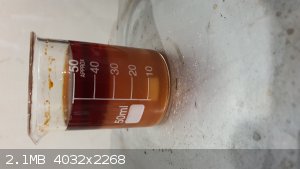
I have no idea why this colour change did not spread to the rest of the solution, but since the steel wool was at the bottom of the beaker (just on
top of the magnetic stirring disc, not sure if it's visible) and the top was exposed to air, I think it's reasonable to assume that the steel wool
reduced the Fe(III)-kojate complex to Fe(II). One paper suggests that L-cysteine can reduce the Fe(III)-kojate complex, and the cysteine/dithiodicysteine couple is less reducing than the
Fe0/Fe2+ couple (-0.22 V vs -0.447 V), so it's plausible that the metallic iron reduced some of the Fe(III) (though I will say that I'm surprised that the metallic
iron could dissolve in such an alkaline environment).
I then turned on stirring and let it sit for another 5 min or so. The solution then turned beige-brown, which is reasonably similar to the
colour of other Fe(II)-complexes with oxygen-donor ligands (e.g. ferrous gluconate) so I thought the reduction of Fe(III) was mostly complete.
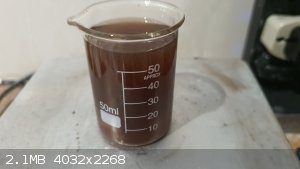
Separately, I prepared an ethanol solution of ferrous chloride by reacting 0.31 g of iron powder (~0.0055 mol) with 1 mL of 32% hydrochloric
acid (~0.01 mol) in ~50 mL ethanol. A small excess of iron powder was used to account for impurities and to keep the Fe(II) in solution from oxidising
once the reaction approaches completion. The solution was heated to boiling in an open bottle, then allowed to cool for about 1 min before a cap was
placed over it to minimise oxygen exposure and left to finish reacting. This was done to displace as much oxygen as possible with hydrogen and ethanol
vapour.
In my experience, FeCl2 is one of those compounds which seems to be very difficult to keep from oxidising even when dried - I've opened
fresh, sealed bottles of AR grade ferrous chloride from Sigma-Aldrich which are yellow, indicating oxidation to Fe(III). Hence, I think it's better to
prepare FeCl2 from scratch each time it's needed.
Once both solutions were ready, I filtered the iron(II) chloride solution first, obtaining a clear, pale green filtrate. Then, I filtered the
lithium kojate solution directly into the iron(II) chloride, similar to the setup for manganese(II) kojate. With each drop of lithium kojate added to
the FeCl2, a dark orange-brown colour formed:
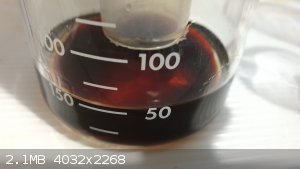
Unfortunately, even after all the lithium kojate was added, no precipitation was observed. Even adding an additional 50 mL of ethanol did not
induce any precipitation:
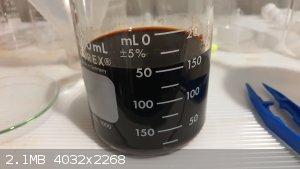
I ended up bringing the solution to a university lab which had a centrifuge. Occasionally, a suspension of very fine dark-coloured precipitate
is difficult to distinguish from a dark-coloured solution. However, centrifuging samples of the solution at 40,000 rpm for 5 min only resulted in a
very small amount of black precipitate at the bottom:
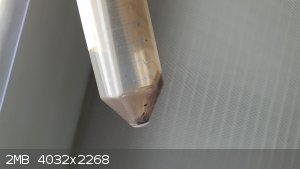
Since it was clear that the ferrous kojate was not precipitating from ethanol, I decided to try various anti-solvents. Unfortunately, the
selection is rather limited because the anti-solvent also needs to be able to dissolve lithium chloride so that the ferrous kojate can be isolated.
After trying higher alcohols (1-propanol, isopropanol), non-polar solvents (toluene), what finally worked was ethyl acetate. The ferrous kojate is
still slightly soluble in ethyl acetate (a very faint orange colour was observed after washing off the ethyl acetate) but it's the best option as it should dissolve LiCl.
Once the washing was complete, I scraped the precipitate onto a glass petri dish and dried it on a hotplate set to 80 deg C. After a short
period, a very dark brown-black gooey crust was obtained:
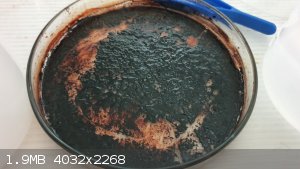
I was concerned that I had burnt or otherwise damaged the ferrous kojate. However, when I scraped it off and placed it into water, a dark orange-brown
solution identical to that of the initial ferrous kojate/lithium chloride ethanol solution:
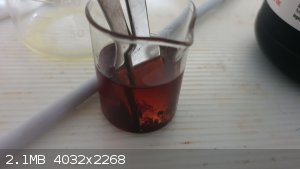
At minimum it suggests that there is a ferrous complex of some sort in there, even if I'm not 100% certain that it's ferrous kojate (e.g. the kojic
acid could have oxidised to comenic acid while in contact with air).
Interestingly, upon dilution, you can see that the aqueous solution of ferrous kojate is actually orange (in contrast to ferric kojate, which is red):
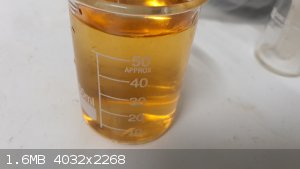
Orange is a reasonably common colour for hydrated ferrous complexes e.g. ferrous gluconate ranges from yellow to orange-brown depending on the pH of the solution, ferrous fumarate ranges from red to orange, and ferrous
glycinate is orange when hydrated (and when prepared pure, i.e. without citric acid or ascorbic acid). For ferrous kojate, the intensity of the
complex absorption appears to be so high that solutions appear black at sufficiently high concentration.
Unfortunately, the complex appears to have dried as a gooey crust which has not responded to further heating (no ethyl acetate or ethanol vapours are
apparent, whereas they definitely were previously). I don't have any particular use for ferrous kojate, so if I can't dry it any further I might toss
it out. As kojic acid is a naturally-occurring fungal metabolite, presumably the complex can be dumped into soil or similar (iron(II) is non-toxic to
soil life and is even considered a fertiliser in iron-deficient/alkaline/high-phosphate soils).
|
|
|
DraconicAcid
International Hazard
    
Posts: 4278
Registered: 1-2-2013
Location: The tiniest college campus ever....
Member Is Offline
Mood: Semi-victorious.
|
|
I just did a reaction between aqueous copper(II) acetate and kojic acid (about 60 C). There was an immediate formation of a reddish-brown
precipitate, which I collected by vacuum filtration, washing with water and isopropanol. The brown ppt seems to be turning greenish upon drying.
Please remember: "Filtrate" is not a verb.
Write up your lab reports the way your instructor wants them, not the way your ex-instructor wants them.
|
|
|
KoiosPhoebus
Hazard to Self
 
Posts: 51
Registered: 23-1-2023
Member Is Offline
|
|
Quote: Originally posted by DraconicAcid  | | I just did a reaction between aqueous copper(II) acetate and kojic acid (about 60 C). There was an immediate formation of a reddish-brown
precipitate, which I collected by vacuum filtration, washing with water and isopropanol. The brown ppt seems to be turning greenish upon drying.
|
Oh, that's really interesting. I actually had the opposite experience, where the
precipitate went from yellow/green to reddish-grey. I've taken a few pictures and I wonder if the colours I saw were similar to yours, but in reverse
for some reason.
A while back, I did a similar reaction, but between copper(II) sulphate and potassium kojate (deprotonating the kojic acid using potassium hydroxide
as the base).
At first, I got a yellow-greenish precipitate:
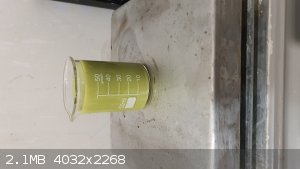
I then poured the mixture into two 50mL centrifuge tubes and left it to settle overnight, planning to decant the supernatant in the morning. However,
in the morning, I noticed that the precipitate had changed colour to a shade of greyish-red (the supernatant remained greenish):
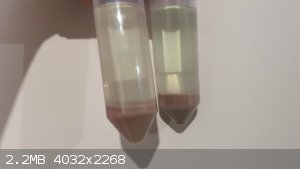
My guess is that a redox reaction occurred between the copper(II) and the kojate anions, which resulted in the formation of copper(I) oxide (the red
colour). The solution remaining green might indicate the presence of some unreacted, dissolved copper(II)-kojate complex. While I can't find any
literature on a copper(II)-kojate redox reaction specifically, it's known that kojic acid is an antioxidant (i.e. is reducing), and copper(II) ions are capable of oxidising chelating anions which are also reducing agents
(e.g. ascorbic acid/ascorbate).
An interesting point is that the red precipitate seems to have primarily formed towards the top of the pellet:
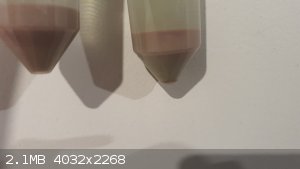
@DraconicAcid, apparently it's possible to prepare complexes between copper(II) and reducing ligands by grinding the metal acetate with the ligand (Solvent-free Synthesis of Copper(II) Cysteine Complexes). I don't have copper(II) acetate myself, but if you still have some, it might be a
procedure worth trying to see if you get a similarly-coloured complex.
|
|
|
|